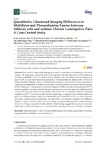Mostrar o rexistro simple do ítem
Quantitative Ultrasound Imaging Differences in Multifidus and Thoracolumbar Fasciae between Athletes with and without Chronic Lumbopelvic Pain: A Case-Control Study
| dc.contributor.author | Almazán Polo, Jaime | |
| dc.contributor.author | López-López, Daniel | |
| dc.contributor.author | Romero Morales, Carlos | |
| dc.contributor.author | Rodríguez Sanz, David | |
| dc.contributor.author | Becerro-de-Bengoa-Vallejo, Ricardo | |
| dc.contributor.author | Losa Iglesias, Marta Elena | |
| dc.contributor.author | Bravo-Aguilar, María | |
| dc.contributor.author | Calvo-Lobo, César | |
| dc.date.accessioned | 2020-10-13T15:41:08Z | |
| dc.date.available | 2020-10-13T15:41:08Z | |
| dc.date.issued | 2020-08 | |
| dc.identifier.citation | Almazán-Polo, J.; López-López, D.; Romero-Morales, C.; Rodríguez-Sanz, D.; Becerro-de-Bengoa-Vallejo, R.; Losa-Iglesias, M.E.; Bravo-Aguilar, M.; Calvo-Lobo, C. Quantitative Ultrasound Imaging Differences in Multifidus and Thoracolumbar Fasciae between Athletes with and without Chronic Lumbopelvic Pain: A Case-Control Study. J. Clin. Med. 2020, 9, 2647. | es_ES |
| dc.identifier.issn | 2077-0383 | |
| dc.identifier.uri | http://hdl.handle.net/2183/26404 | |
| dc.description.abstract | [Abstract] New trends in ultrasound imaging are focused on exploration of morphology and muscle quality. The main goal of the study was to evaluate the first-order descriptor and echostructure of lumbar multifidus at the L4 vertebral level in athletes with and without chronic lumbopelvic pain (CLPP). A case-control study was performed in 15 semiprofessional athletes with CLPP and 15 without (healthy athletes). Lumbar multifidus echointensity and echovariation were measured for muscle quality assessment. Echostructure was used to evaluate lumbar multifidus cross-sectional area (CSA) at resting and during muscle contraction, respective differences during both phases (CSADif.), activation patterns, and thoracolumbar fasciae morphology and thickness. Significant differences with a large effect size were observed in quantitative data from CLPP and healthy athletes for left lumbar multifidus CSADif. and thoracolumbar fasciae morphology. Categorical data showed statistically significant differences with a small-to-moderate effect size for lumbar multifidus activation pattern and thoracolumbar fasciae morphology. Athletes with CLPP showed a reduced CSA difference between lumbar multifidus contraction and at resting and higher disorganization of thoracolumbar fasciae morphology compared to healthy athletes. These findings suggest the importance of dynamic exploration of the lumbar region and connective tissue in sports performance and injury prevention. | es_ES |
| dc.language.iso | eng | es_ES |
| dc.publisher | MDPI AG | es_ES |
| dc.relation.uri | https://doi.org/10.3390/jcm9082647 | es_ES |
| dc.rights | Atribución 4.0 España | es_ES |
| dc.rights | CC-BY-4.0 | es_ES |
| dc.rights.uri | http://creativecommons.org/licenses/by/4.0/es/ | * |
| dc.subject | Ultrasonography | es_ES |
| dc.subject | Iower back pain | es_ES |
| dc.subject | Athletes | es_ES |
| dc.subject | Grayscale analysis | es_ES |
| dc.subject | Quantitative ultrasound imaging | es_ES |
| dc.subject | Lumbar multifidus | es_ES |
| dc.subject | Cross-sectional area | es_ES |
| dc.title | Quantitative Ultrasound Imaging Differences in Multifidus and Thoracolumbar Fasciae between Athletes with and without Chronic Lumbopelvic Pain: A Case-Control Study | es_ES |
| dc.type | info:eu-repo/semantics/article | es_ES |
| dc.rights.access | info:eu-repo/semantics/openAccess | es_ES |
| UDC.journalTitle | Journal of Clinical Medicine | es_ES |
| UDC.volume | 9 | es_ES |
| UDC.issue | 8 | es_ES |
Ficheiros no ítem
Este ítem aparece na(s) seguinte(s) colección(s)
-
GI-UDISAP - Artigos [196]






